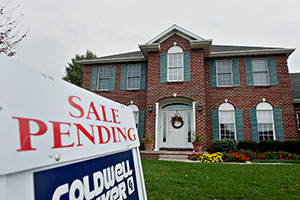Pending Sales of Existing Homes Fell in June

Fewer Americans signed contracts in June to buy previously owned homes, representing a pause in the housing market’s momentum.
The index of pending home sales unexpectedly fell 1.8%, the first drop this year, after a revised 0.6% increase in May that was smaller than initially reported, figures from the National Association of Realtors showed July 29 in Washington. The median forecast of 37 economists surveyed by Bloomberg News called for a 0.9% gain.
The data are consistent with the slow improvement in housing, restrained by still-tight lending standards and a limited selection of available properties. An easing of those conditions, along with an acceleration in wage growth, would allow more Americans to take advantage of cheap borrowing costs and provide more of a tailwind for real estate.
“We still have quite a ways to go before we can talk about a robust housing market,” Lindsey Piegza, chief economist at Stifel Nicolaus & Co. Inc., said before the report. “The consumer still remains under a lot of pressure.”
Estimates in the Bloomberg survey of economists ranged from a decline of 1.5% to an increase of 2.5% after a previously reported 0.9% advance in May.
Two of four regions showed a decline in contract signings from a month earlier, with the South and Midwest posting 3% decreases.
Purchases rose 11.1% in June from the previous year on an unadjusted basis after a 7.9% increase in the 12 months that ended in May, the association reported.
“Competition for existing houses on the market remained stiff last month as low inventories in many markets reduced choices and pushed prices above some buyers’ comfort level,” the group’s chief economist, Lawrence Yun, said in a statement. “A combination of homebuilders ramping up construction and even more homeowners listing their properties on the market is needed to tame price growth and give all buyers more options.”
The pending home sales index was 110.3 on a seasonally adjusted basis, down from May’s 112.3 that was the strongest in nine years. A reading of 100 corresponds with the average level of contract activity in 2001, according to NAR.
Economists consider pending sales a leading indicator because they track new purchase contracts. Existing-home sales are tabulated when a contract closes, usually a month or two later.
Figures released by Realtors group earlier this month showed sales of previously owned homes climbed to an eight-year high in June. The median time a home was on the market was 34 days, the fewest in records going back four years.
Purchases of new U.S. homes fell 6.8% to a 482,000 annualized pace in June — the weakest since November, Commerce Department figures showed last week.
Such mixed signals have been typical of the housing recovery this year. While steady job growth and low interest rates have been helping to prop up demand, they’ve been countered by tight lending standards for some Americans and a limited selection of available homes.
The economy has added about 1.3 million jobs in 2015, while the unemployment rate, at 5.3%, is the lowest since 2008.
Smaller increases in home prices would help improve affordability for first-time and young buyers. The S&P/Case-Shiller index of property values increased 4.9% from May 2014 after rising 5% in the year ended in April, the group said July 28 in New York.


